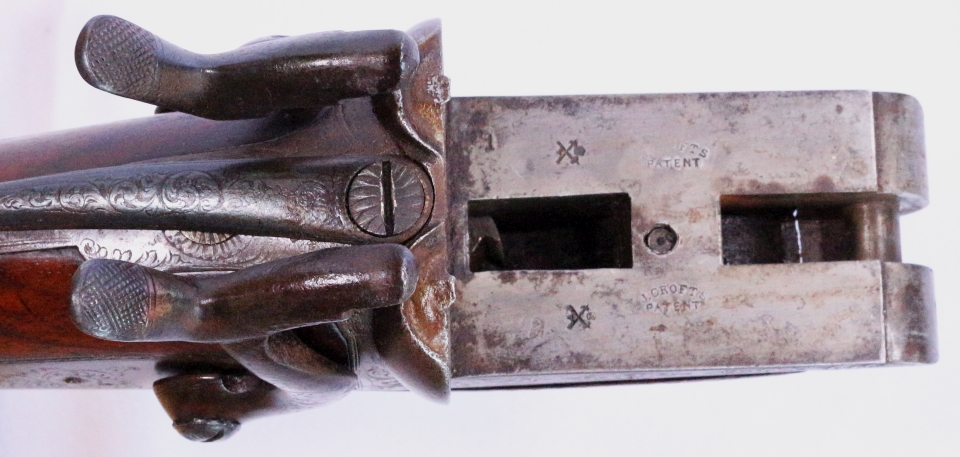This gun is intriguing for both the maker and the action, and as is often the case with mid-Victorian British guns, an examination leaves many more questions unanswered than would be the case with later guns having the benefit of better and more complete records. The first breech-loaders were all experimental in their way, some more than others.
This one is unusual in having a top lever action which isn’t the W&C Scott design. It fastens the barrel with a small rotating cam bolt engaging a single bite, which is not very strong compared with later formulations. The top lever is quite long and, while effective, it does not feel as solid as other top-lever guns of the period, such as those by Westley Richards. It is the design of the Birmingham gunmaker John Crofts, who received his patent on 11 April 1866 (Patent No. 1033).
Little is known about this maker, and John Crofts went out of business in 1868, so the action was likely to have been made at some time around these dates. In over 25 years of searching for and researching the British pin-fire game gun, I’ve not seen another, or heard of one. Whether the gun was made by Crofts, or the action sold in the white, will never be known.
Crofts is not the name inscribed on the rib and locks. The rib carries the address “27 New Bailey St. Salford Manchester”, and the locks the name “Hambling”. This is confusing, as the name “Hambling” does not appear in any available gunmaker references for Manchester. The Hambling gunmakers in Blackawton, Devon, include the father, William Bartlett Hambling, and his seven sons: William Baker, James, John, Charles George, Hiram Bartlett, Henry, and Reuben.

Reuben Hambling is known to have been in business on his own in 1858 in Brighton, and it appears that he moved to the North of England; from genealogies and other information, Reuben Hambling was in Manchester in the period of this gun (his daughter, Fanny, was born there in 1869), and he was the only Hambling known to have made guns in Manchester.
On 14 Oct 1865 the local newspaper The Bury Times published a small article titled "Gunpowder Explosion in Salford”. The article went on: “On Saturday evening, about half-past seven o'clock, two lads went into the shop of Mr. R. Hambling, gunsmith, Bexley-street, near the Salford Town Hall, to buy a pennyworth of gunpowder. An old man, named Cadden, was serving them out of a small canister, when by a mishap the gaslight from a bracket near the counter ignited the powder, which exploded. The canister contained about one and a half pound. The effect of the explosion was signally destructive.
The contents of the shop window, guns and powder flasks, with the window frame and shutters, were all swept into the street. The lads and shopman were burned on the face and hands, but their injuries were not serious." As there is both a New Bailey Street and a New Bexley Street in Salford, there is no way of knowing if the newspaper made an error, or if Reuben Hambling moved from one location to another. He didn’t stay long in Manchester and later worked for E. M. Reilly & Co. in London, finally moving to Ashford, in Kent. Reuben Hambling died in 1891.

Sadly the gun is not in very good condition, but I’m glad I didn’t wait for another to come along. It is a 12-bore bar-in-wood pin-fire, with 30” Birmingham-proofed barrels. The barrels also carry the mark “Roses Patent”. The Rose Brothers (Hales-Owen Mills & Forge) were barrel makers located in Halesowen, Worcestershire, operating between 1860 and 1892. They were well-known for barrels made using a patented method for machine-production of damascus barrels. The action flats are signed “Crofts Patent” and the back locks simply “Hambling”. The top-lever return spring is now weak, the bores are heavily pitted, and the gun weighs 7 lb 11 oz.
There are a number of obscure snap-actions that appeared in the 1860s, but most were variations on the same designs, or they simply didn't catch on. Nowadays we don’t give much thought to hinge actions, but they are part of an interesting evolution of ideas, engineering, and practical production, and are worth the attention of collectors. If anyone has information on other Crofts patent actions, or guns by Crofts or Reuben Hambling, please let me know.

NOTES: I would like to acknowledge the Internet Gun Club, for graciously allowing the use of information from their extensive historical database.
Stephen Nash.
Published by Vintage Guns Ltd on




